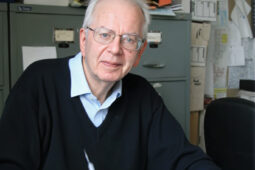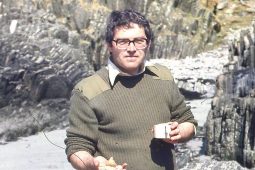William David Ian Rolfe (1936-2025)
Ian was a dedicated palaeontologist, best known for his work on Carboniferous arthropods.

Ian Rolfe (© Mikiko Ridd)
Born in Hornchurch, Essex, in 1936, William (Ian) Rolfe attended the Royal Liberty School where he was taught by John Reekie, an inspirational geology teacher. He gained a BSc and PhD from the University of Birmingham, with a thesis on the Silurian inliers of Scotland’s Midland Valley, including work on the pod-shrimp Ceratiocaris, which shaped his future career.
Curiosity and collections
A spell (1961-2) curating the non-trilobite arthropods of Harvard University’s Museum of Comparative Zoology allowed Ian to demonstrate that the two-metre long Carboniferous Arthropleura was a terrestrial forest dweller, not an aquatic trilobite relative as previously thought.
He was then appointed as a curator at the University of Glasgow’s Hunterian Museum, a post he held for 24 years, during which his energy and imagination raised his and the museum’s scientific profile. In 1967, he joined an expedition to the Upper Devonian reefs of Gogo, Western Australia, where superbly-preserved fish and over two thousand fossil phyllocarid crustaceans were collected, on which he later published.
An increase in Hunterian Museum staffing in 1978 included amateur fossil collector Stan Wood, who had a gift for spotting and extracting fossils and became well-known for discovering the earliest fully terrestrial amphibians at Bathgate in West Lothian. This included a reptile-like early vertebrate nicknamed Lizzie. As Stan’s supervisor, international competition to buy this important fossil brought Ian into contact with politicians and broadcasters, including David Attenborough, as he made the case successfully to keep Lizzie in Scotland.
His energy and imagination raised his and the Hunterian Museum’s scientific profile
In 1986, Ian moved to Edinburgh to become Keeper of Geology at the National Museum of Scotland. His exhibition work concentrated on developing briefs for the new Museum of Scotland, which opened in 1998. Meanwhile, he continued to support Stan’s work, many of whose important finds Ian was able to acquire for the museum.
Ian retired in 1996, when he turned his research to the seventeenth century Italian naturalist Cassiano dal Pozzo and the many geological artefacts in his ‘Paper Museum’.
Dedication and distinction
A Fellow of the Geological Society since 1960, in 1973 Ian became editorial chairman of the Society’s journal, and in 1980, chairman of its Conservation Committee. He was awarded the Society’s Murchison Fund in 1978, and one of the first two Coke Medals in 1984. He was also President of the Palaeontological Association and the Geological Societies of Glasgow and Edinburgh at different times, as well as a Fellow of the Royal Society of Edinburgh.
Ian passed away in Edinburgh on 26 September 2025. He was a brilliant researcher and a polymath with a bookish character. He loved books and yet he had no time for novels. He had no time for sport either, yet liked walking the Scottish hills with friends or spending time at his shared cottage beside Loch Linnhe. Since childhood he was a devoted choral singer also. Ian’s wife Julia pre-deceased him, but he is survived by daughters Sara and Victoria and two grandchildren.
By Michael F Ridd











